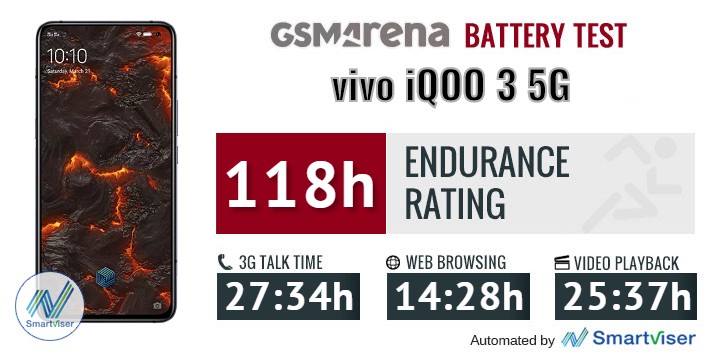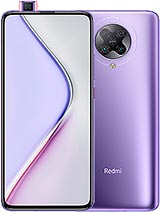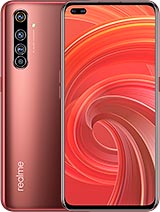vivo iQOO 3 5G review
Introduction
What makes a gaming phone? Powerful internals, high refresh rate display, flashy design, extreme cooling, extra controls? Well, the vivo iQOO 3 5G has only some of these checkboxes ticked, but is that a bad thing? We'll set off to find out.

Okay, the extra controls are there - in the form of the Monster Touch shoulder buttons on the right side of the handset. Speaking of monsters, Monster Inside is the tagline for the iQOO 3 5G, and if that alludes to the Snapdragon 865, we'd agree - it's as potent a chipset as they come on an Android smartphone right now. The fastest-available UFS 3.1 storage can only be found inside this vivo and a handful of other phones at the time of writing, so the powerful internals are accounted for as well.
Vivo advertises a 'Carbon Fiber Vapour Cooling System' which isn't quite as extreme as a built-in (nubia Red Magic 5G) or a snap-on (ROG Phone II) fan, but it's something - we'd say the iQOO is half-way there on the 'extreme cooling' bit.
For better or worse, the iQOO 3 5G is missing that 'gaming' design with sharp lines and bright red or green colors. It does come in a striking orange color option, which we'll have a look at on the next page, but it's otherwise an inconspicuous handset. So - no gaming aesthetic, but in a good way.

Which brings us to the one major omission when it comes to the iQOO 3 5G's gaming aspirations - it's only got a a 'plain' 60Hz screen. More is better when it comes to the refresh rate, and other gaming phone alternatives deliver. It's still a pretty great AMOLED screen as our tests will show, and with a 180Hz touch sampling it should be plenty quick to detect action.
Here's rundown of the iQOO 3 5G's key specs before we move on.
vivo iQOO 3 specs
- Body: 158.5x74.9x9.2mm, 215g; Gorilla Glass 6 front and back, aluminum frame.
- Display: 6.44-inch Super AMOLED, 1080 x 2400px, 409ppi; HDR10+ certified; 60Hz refresh, 180Hz touch-sensing.
- Rear camera: Primary: 48MP, 1/2.0", f/1.8, PDAF; Telephoto: 13 MP, f/2.5, 50mm, PDAF, 2x optical zoom; Ultra-wide: 13 MP, f/2.2, 16mm AF; 2MP, f/2.4 depth sensor; LED flash; 2160p@30fps video recording, gyro-EIS.
- Front camera: 16MP, f/2.5.
- Chipset: Qualcomm Snapdragon 865 (7nm+): Octa-core (1x2.84 GHz Kryo 585 & 3x2.42 GHz Kryo 585 & 4x1.8 GHz Kryo 585), Adreno 650.
- Memory: 128GB 6GB RAM, 128GB 8GB RAM, 128GB 12GB RAM, 256GB 8GB RAM, 256GB 12GB RAM; UFS 3.1.
- OS: Android 10; iQOO UI 1.0.
- Battery: 4,400mAh, 55W Super FlashCharge 2.0 fast charging.
- Connectivity: 5G (only on the 256GB 12GB variant in India), Dual SIM, Bluetooth 5.0, Wi-Fi a/b/g/n/ax/ax, dual GPS, USB-C.
- Misc: Monster Touch Buttons, 4D vibration, in-display fingerprint reader, AK4377A independent audio chip with Hi-Res audio certification.
vivo iQOO 3 5G unboxing
The iQOO 3 5G comes in a distinctive box with a black carbon fiber print and the brand name stamped on top in shiny gold letters. A sticker indicates that ours is the 5G version (fully tricked out with 256GB of storage and 12GB of RAM), but 4G-only options are also available with less storage and RAM. The lid's sides diagonally cut which is a nice accent.

Inside the box, there's the phone in a plastic tray. Below that, you'll find a paper sleeve that holds a frosted plastic protective case and the USB cable with a red-and-white pill-shaped connector on the phone end that leads the cable at a 90-degree angle away from the device.
Digging deeper, there's the 55W charger - it's big and heavy, no two ways about it, but it's also fast. The list of accessories also includes a set of in-ear buds.
Design
The iQOO 3 5G is a built-in a familiar fashion for a modern smartphone from the upper echelons. An aluminum framework keeps things together and is exposed all around, while both the front and back panels are made of glass - Gorilla Glass 6, the specs say.

That's the basics, but there are details that are specific to the iQOO 3. Chief among those are the Monster Touch buttons. On the right side of the phone (or, rather, on top when you hold in right side up), in the opposite ends, there are these flattened zones in the frame which serve as shoulder buttons for in-game actions. They are labeled 'L' and 'R' in case you forget which way is which.
The buttons have 'touch' in their name, and we initially thought they worked capacitively, but after more careful examination, we're confident they require an actual press, a reasonably firm one. Think of it like the squeeze function on Google Pixels.


Monster Touch buttons
On this same side of the phone, there's also the power button and the volume rocker. Both are made of metal and have a very reassuring click action. The power button itself is textured so you can recognize it by touch alone. It's also orange which serves as a nice accent against the black satin frame.

While on the subject of colors, our review unit is in the Tornado Black color scheme. Well, black it isn't - strictly speaking, it's more of a dark purple around the periphery with a lighter hue in the middle. There's also a dotted pattern to be seen under the glass.

The camera assembly is in the top left corner with all the bits housed in a common raised area. Top to bottom, we have the flash, the 2MP depth sensor, the primary 48MP module, and the ultra-wide shooter. Alone to the right is the 2x zoom telephoto. A fairly discreet set of camera specs is printed here too.

Two other options are available - a Quantum Silver one we only caught a glimpse of at announcement time and the Volcano Orange one we got to play with a bit more.
That last one is the closest that the iQOO 3 5G gets to having the amount of flair expected from a gaming device. But even that is somehow more of a whacky and eye-catching colorway on an ordinary phone than a true gaming aesthetic. We can't say we don't appreciate the design restraint.

On the left side of the iQOO3 5G, directly opposite the volume down button, is what vivo interchangeably calls the AI button or Smart button. We'll talk more about it in the software section of this review, but let's just quickly mention here that you can disable it completely if that's what you wish.
The same flattened areas at the ends of this side of the frame don't have the 'L/R' designation, and unsurprisingly don't function as buttons.

On the bottom of the phone is where you'll find the USB-C port, centered. To the left of it is the primary mic for voice calls and the card slot - sadly, that'll only take two nanoSIMs but no microSD. The loudspeaker is to the right.
Up top is the secondary mic for in-call noise canceling. Here you'll also find the 3.5mm headphone jack - we've almost forgotten what these looked like, but we're always happy to see one.


Bottom view • Top view
A grille drilled out of the frame above the display serves to let out the sound of the earpiece, we don't recall quite the same particular placement. It's more than a little disappointing that this earpiece doesn't double as the second speaker - stereo sound is a must for a gaming phone, the way we look at things.
The 6.44-inch AMOLED display is surrounded by reasonably-sized bezels, equally sized on the sides and the top, a bit thicker on the bottom. A tiny cutout in the top right corner of the panel lets the selfie camera see the light of day - and it is one of the smallest punch holes we've seen.
The phone does come with a factory-installed screen protector, which is nice and all, but it just bugs us immensely that the hole for the selfie camera isn't centered around the actual selfie camera.


The tiniest of punch holes • Chin isn't too thick.
The iQOO 3 5G is quite the hefty unit, tipping the scales at 215g. That's kind of the norm for the segment though with the Redmi K30 Pro weighing in at 218g and the Realme X50 Pro 205g. It's a marginally chunkier unit too - it's 9.2mm thick next to the 8.9mm of each of these other two. The iQOO 3 5G's footprint is similar to the Realme's with which it shares a 6.44-inch display diagonal, while the Redmi is slightly bigger physically because it has a larger 6.67-inch screen.
Very bright 6.44-inch AMOLED panel
The iQOO 3 5G has a Super AMOLED display with a 6.44-inch diagonal. It's got a 1080x2400px resolution in a 20:9 aspect ratio and a pixel density of 409ppi. A few of those pixels are eaten away by the selfie cam cutout, but it is one the smallest punch holes, so we'll give it a pass.

An important omission on the iQOO 3 5G display specsheet is a high refresh rate. Yes, it does feature 180Hz touch sampling, so it'll register input plenty quick, but the display can only refresh at 60Hz so game titles are capped at 60fps too. High-end smartphones of the day come with 120Hz or at least 90Hz panels and the 60Hz of the vivo are particularly disappointing given its focus on gaming.
One area we can't complain about is brightness. We measured a maximum of 848nits in auto mode when the iQOO 3 5G was under direct light and 518nits with the auto toggle disengaged - both numbers among the best on the market. Minimum brightness was also a very good 2.1nits.
| Display test | 100% brightness | ||
| Black, | White, | ||
| 0 | 518 | ∞ | |
| 0 | 848 | ∞ | |
| 0 | 536 | ∞ | |
| 0 | 871 | ∞ | |
| 0 | 483 | ∞ | |
| 0 | 685 | ∞ | |
| 0 | 519 | ∞ | |
| 0 | 522 | ∞ | |
| 0 | 892 | ∞ | |
| 0 | 379 | ∞ | |
| 0 | 797 | ∞ | |
| 0 | 440 | ∞ | |
| 0 | 589 | ∞ | |
Color handling on the iQOO 3 5G is done with a selection of three modes and an additional stepless cool-to-warm slider. The out of the box Standard mode is the way to go for vivid colors and a wide gamut, and it does a fairly decent job of reproducing the DCI-P3 color space. We measured an average deltaE of 4.6, but the white point and the entire grayscale were shifted towards blue (deltaE of around 10 for the bunch of them). Bumping the slider midway to the right warms up the white point to a near perfect deltaE of 1, but the darker grays do keep a bluish tinge, even if they do improve a lot. The average deltaE, in this case, is 2.8.
The Normal mode is tuned for sRGB content, and we measured an average deltaE of 2.7 for our sRGB test swatches. The familiar perceived lifelessness of such modes is present here as well.
Bright mode is overall about as accurate as Standard - an average deltaE of 5.1 for our set of DCI-P3 patterns. It's not brighter per se either.
The iQOO 3's display is HDR10+ compliant. It's still not on Netflix's list of supported devices, however, despite having the proper DRM capabilities (Widevine Level 1). YouTube does serve HDR videos to the phone, and you can see it automatically switch its colors and brightness accordingly when it detects HDR content.
vivo iQOO 3 5G battery life
The iQOO 3 5G relies on a 4,400mAh power pack to keep the lights on and it's a sensible capacity given the less power-hungry 60Hz display - throw in a high refresh rate panel, and it's too little as we saw on the nubia Red Magic 5G (6.65", 144Hz, 4,500mAh, 83h).
The iQOO 3 5G also manages to convert its battery capacity into the screen-on time in a very efficient manner. We clocked more than 25 hours of looping videos offline and 14:28h of web browsing over Wi-Fi - properly excellent results. The 3G talk time wasn't as impressive, but easily good enough at 27:34h. A decent-to-good standby measurement despite the flagship Snapdragon's external modem rounded up a commendable performance from the iQOO 3 5G, summed up in a 118h Endurance rating.

Our battery tests were automated thanks to SmartViser, using its viSer App. The endurance rating above denotes how long a single battery charge will last you if you use the vivo iQOO 3 5G for an hour each of telephony, web browsing, and video playback daily. We've established this usage pattern so that our battery results are comparable across devices in the most common day-to-day tasks. The battery testing procedure is described in detail in case you're interested in the nitty-gritty. You can check out our complete battery test table, where you can see how all of the smartphones we've tested will compare under your own typical use.
vivo's promo materials state a charging time of 15 minutes to 50%, but in our experience, it took 18mins - still properly fast. At the 30-minute mark, we were looking at 76%, which is another great achievement. The charging rate tapers off around that time, and a full charge is reached in 50 minutes.
Those numbers are for the bundled 55W adapter and the proprietary cable. Using industry-standard USB PowerDelivery peripherals will mean a slower charging time.
Speaker test
The vivo iQOO 3 5G has a single bottom-firing speaker - a stereo setup would have fit its high-end and/or gaming aspirations better. It's decently loud, earning a 'Good' rating in our test, but it does so with unimpressive sound quality characterized by muffled highs and practically non-existent lows.
Use the Playback controls to listen to the phone sample recordings (best use headphones). We measure the average loudness of the speakers in LUFS. A lower absolute value means a louder sound. A look at the frequency response chart will tell you how far off the ideal "0db" flat line is the reproduction of the bass, treble, and mid frequencies. You can add more phones to compare how they differ. The scores and ratings are not comparable with our older loudspeaker test. Learn more about how we test here.
Android 10 with brand new iQOO UI
The iQOO 3 5G runs Android 10 but you couldn't tell without looking in the menus - the in-house customizations are really thorough. Having said that, this phone's iQOO UI isn't quite as iOS-like as vivo's previous FunTouch efforts.

It has a proper notification shade with quick toggles in it, as opposed to the previous approach with a Control center on the bottom and notifications from the top. And it works almost like any other notification shade - you pull down from the top and a row of toggles appears, notifications cards below it; pull down again and you get the entire grid of toggles.
We say 'almost' though, because it has its idiosyncrasies. For example, there's no shortcut to the settings menu on the first pull - it only appears after the second swipe down, in an area previously unoccupied by anything - why the extra step? And then, to dismiss the shade if it's full of notifications, you need to swipe up from the very bottom of the screen, as if you're doing the 'Home' gesture. It's a bit counterintuitive.


Notification shade
Speaking of gestures, the Android 10 default navigation implementation is how the iQOO 3 5G operates out of the box. Some other custom launchers add a swipe and hold gesture from the side to switch between the last two apps, but not iQOO UI. It does use that gesture for something, though - it's called 'Quick launch apps' and it's a five-icon shortcut menu, where you can add any app installed on the phone. You can't add the flashlight, for example, which we feel is a missed opportunity. You can disable the feature entirely too.
Other navigation options are also available including the swipe from the bottom variety which operates like a nav bar, only with swipes, as well as the classic nav bar itself.






Navigation options and shortcut menu
One entirely custom solution on the iQOO 3 is the extra hardware button on the left side of the phone, directly opposite the volume down button. vivo interchangeably calls it the AI button or Smart button. It recognizes three actions - press, double press, and press and hold. In its out of the box state, the first and third action will summon Google Assistant, while the double press launch Jovi Vision - an in-house tool that scans your screen and tries to find items to buy within it (best used within the camera app, if it wasn't obvious).
Each action can be assigned to open up a Google search or deactivated, so you can effectively remove the hardware AI button in software. You can't set it to launch an app or a function of your choice, so still no flashlight shortcut.

AI button options
The iQOO 3 5G has an always-on display feature, which you can customize to your heart's content. Dark mode for the entire UI is also present.






Dark mode • Always on display
Biometric security comes in two flavors - an under display optical fingerprint reader and a camera-only face recognition. Fingerprint recognition works excellently fast, every time - we believe that optical FPR tech has matured enough to be as quick as the capacitive sensors of the past. The sensor is perhaps a tiny bit too low (say, for example if you're coming from a Galaxy Note10+), but you'll get used to it in no time.
The facial recognition works extremely fast too, even in pitch darkness, where it lights up the display real quick (a little, not blinding you). While it does require at least one open eye to unlock, it's still a relatively insecure authentication method, mind you.





Biometrics and security
There's a bunch of gaming-focused software features baked in too, operated from within the Ultra Game Mode hub of sorts. That's is accessed from the main settings menu or by long pressing the toggle in the notification shade, which also serves a global on/off switch of the features. Game assistant will show a popup informing you it's got everything optimized and briefing you on current settings - you can disable it after you're tired of seeing it. Game sidebar is where you'll be able to change settings mid-game - handle alerts, screen recording, and the pressure sensitive buttons assignment, among others. You can customize the options in this sidebar as well as disable it completely and only set the things from the Ultra Game Mode Optimization Center.








Gaming settings
Synthetic benchmarks, sustained performance
The iQOO 3 5G has some proper flagship internals. For starters, it's the Snapdragon 865 at the helm - the very best chipset on an Android phone right now. The handset comes in several different RAM/storage tiers with 6GB, 8GB or 12GB of RAM, and 128GB or 256GB of storage. Our review unit is the top spec with 12 gigs of RAM and 256GB of storage.
And that storage is also the fastest available - UFS 3.1 can only be found here, on vivo's own NEX 3S 5G, or the Redmi K30 Pro and Pro Zoom. Not even the just announced OnePlus 8 Pro has it, and we all know how big OnePlus is on speed.

So we figured we'd start our exploration of the iQOO 3 5G's performance from storage speed. We threw some AndroBench at it and while sequential read and write speeds are in the same ballpark as UFS3.0 devices, the iQOO 3 5G outperformed them in random read and write, more impressively in the read part. Whether you'll be able to feel the difference is a different matter, but the facts are the iQOO is, indeed, faster.
AndroBench Sequential Read (MB/s)
Higher is better
- vivo iQOO 3 5G
1758 - Oppo Find X2 Pro
1687 - Samsung Galaxy S20 Ultra 5G
1619 - Samsung Galaxy Note10+
1530
AndroBench Sequential Write (MB/s)
Higher is better
- vivo iQOO 3 5G
733 - Oppo Find X2 Pro
738 - Samsung Galaxy S20 Ultra 5G
688 - Samsung Galaxy Note10+
570
AndroBench Random Read (MB/s)
Higher is better
- vivo iQOO 3 5G
292 - Oppo Find X2 Pro
206 - Samsung Galaxy Note10+
198 - Samsung Galaxy S20 Ultra 5G
178
AndroBench Random Write (MB/s)
Higher is better
- vivo iQOO 3 5G
240 - Samsung Galaxy S20 Ultra 5G
217 - Oppo Find X2 Pro
206 - Samsung Galaxy Note10+
130
Moving on to our more standard set of benchmarks, the iQOO 3 5G posted excellent numbers in GeekBench under both single-core and multi-core loads.
GeekBench 5.1 (multi-core)
Higher is better
- vivo iQOO 3 5G
3402 - nubia Red Magic 5G
3387 - Oppo Find X2 Pro (120Hz, 1440p)
3269 - Huawei P40 Pro
3197 - Realme X50 Pro
3175 - LG V60 ThinQ 5G
2942 - Samsung Galaxy S20+ (120Hz, 1080p)
2703 - Samsung Galaxy Note10+
2154
GeekBench 5.1 (single-core)
Higher is better
- nubia Red Magic 5G
929 - vivo iQOO 3 5G
928 - Realme X50 Pro
911 - Oppo Find X2 Pro (120Hz, 1440p)
900 - Samsung Galaxy S20+ (120Hz, 1080p)
886 - Huawei P40 Pro
780 - Samsung Galaxy Note10+
776 - LG V60 ThinQ 5G
764
That top-class performance continued into Antutu where the iQOO 3 5G was only bested by cousins Find X2 Pro and Realme X50 Pro.
AnTuTu 8
Higher is better
- Oppo Find X2 Pro (120Hz, 1440p)
593717 - Realme X50 Pro
592447 - vivo iQOO 3 5G
575601 - nubia Red Magic 5G
557056 - Samsung Galaxy S20+ (120Hz, 1080p)
500114 - Huawei P40 Pro
496356 - Samsung Galaxy S20+ (60Hz, 1440p)
489371 - LG V60 ThinQ 5G
485908 - Samsung Galaxy Note10+
438622 - Asus ROG Phone II (60Hz)
384713
Graphics benchmarks also consistently placed the iQOO towards the top of the charts.
GFX 3.1 Manhattan (1080p offscreen)
Higher is better
- Oppo Find X2 Pro (120Hz, 1440p)
87 - Realme X50 Pro
86 - nubia Red Magic 5G
86 - vivo iQOO 3 5G
86 - Samsung Galaxy S20+ (120Hz, 1080p)
85 - Samsung Galaxy S20+ (60Hz, 1440p)
85 - LG V60 ThinQ 5G
81 - Asus ROG Phone II (60Hz)
78 - Huawei P40 Pro
75 - Samsung Galaxy Note10+
68
GFX 3.1 Manhattan (onscreen)
Higher is better
- Samsung Galaxy S20+ (120Hz, 1080p)
75 - vivo iQOO 3 5G
61 - Realme X50 Pro
60 - Asus ROG Phone II (60Hz)
60 - LG V60 ThinQ 5G
59 - nubia Red Magic 5G
59 - Huawei P40 Pro
52 - Oppo Find X2 Pro (120Hz, 1440p)
43 - Samsung Galaxy S20+ (60Hz, 1440p)
43 - Samsung Galaxy Note10+
38
GFX 3.1 Car scene (1080p offscreen)
Higher is better
- Realme X50 Pro
51 - Oppo Find X2 Pro (120Hz, 1440p)
51 - nubia Red Magic 5G
51 - vivo iQOO 3 5G
51 - Samsung Galaxy S20+ (60Hz, 1440p)
51 - LG V60 ThinQ 5G
50 - Samsung Galaxy S20+ (120Hz, 1080p)
50 - Asus ROG Phone II (60Hz)
47 - Huawei P40 Pro
44 - Samsung Galaxy Note10+
43
GFX 3.1 Car scene (onscreen)
Higher is better
- Realme X50 Pro
45 - LG V60 ThinQ 5G
43 - vivo iQOO 3 5G
42 - Samsung Galaxy S20+ (120Hz, 1080p)
42 - nubia Red Magic 5G
41 - Asus ROG Phone II (60Hz)
40 - Huawei P40 Pro
31 - Oppo Find X2 Pro (120Hz, 1440p)
25 - Samsung Galaxy S20+ (60Hz, 1440p)
25 - Samsung Galaxy Note10+
24
3DMark SSE OpenGL ES 3.1 1440p
Higher is better
- vivo iQOO 3 5G
7261 - nubia Red Magic 5G
7250 - Realme X50 Pro
7221 - Oppo Find X2 Pro (120Hz, 1440p)
7159 - LG V60 ThinQ 5G
6864 - Samsung Galaxy S20+ (120Hz, 1080p)
6819 - Samsung Galaxy S20+ (60Hz, 1440p)
6735 - Huawei P40 Pro
6062 - Asus ROG Phone II (60Hz)
5393 - Samsung Galaxy Note10+
4984 - Huawei Mate 30 Pro
4432
3DMark SSE Vulkan 1440p
Higher is better
- nubia Red Magic 5G
6678 - vivo iQOO 3 5G
6675 - Oppo Find X2 Pro (120Hz, 1440p)
6526 - Realme X50 Pro
6472 - Samsung Galaxy S20+ (120Hz, 1080p)
6354 - Samsung Galaxy S20+ (60Hz, 1440p)
6311 - LG V60 ThinQ 5G
6020 - Huawei P40 Pro
5637 - Samsung Galaxy Note10+
4763 - Asus ROG Phone II (60Hz)
4642 - Huawei Mate 30 Pro
4233
The iQOO 3 5G did keep up consistent benchmark scores the same for repeated runs, while also staying relatively cool in the process, indicating a good thermal design and promising sustained high performance.
Delving a little deeper into continued load, we ran the CPU throttle benchmark for an hour. The phone recorded an average of 232,518 billion instruction per second, inching ahead of the nubia Red Magic 5G we recently reviewed with a maximum that was also higher than the nubia's. The iQOO 3 5G did throttle a little, down to 90% of its maximum performance, but even in those dips, it remained close to the nubia's minimum result.









CPU throttle in progress
A total of six cameras
A lot of times on gaming-centric phones, the camera system is lower on the list of priorities. Looking at the iQOO 3 5G's spec sheet, that doesn't appear to be the case here. While there are certainly no extreme telephotos or huge sensors, the phone does have a well-rounded three focal length setup with an extra depth sensing module.

The primary camera is the ubiquitous 48MP Quad Bayer solution - a 1/2.0" sensor with 0.8µm pixels with the RGB color filter above them grouping them into fours to make up 12MP images in the default mode. The lens has an f/1.8 aperture, and while vivo doesn't specify a focal length, we gather it's in the 25-26mm equivalent ballpark. There's no OIS.
A short telephoto module is also present, giving a 2x optical zoom capability. Delivering a 50-ish millimeter equivalent focal length, the lens has an f/2.5 aperture and isn't stabilized. The sensor on this one has a 13MP resolution.
Then there's the ultra-wide cam. Vivo says it covers a 120-degree field of view, shrinking down slightly to 117 when you enable the software distortion correction. And then, the EXIF data reports a 15mm equivalent focal length, which is neither. Anyways, it's pretty wide, and it has autofocus, which is a moderately big deal - even flagship ultrawides are often either very wide but fixed focus, or with autofocus but not all that wide. The aperture on this one is f/2.2, while the sensor has 13MP to work with.
Last, and very much least, there's also a 2MP 'bokeh' camera - one of those modules that typically only up the camera count without contributing much in real life, but everyone keeps doing it.
Over on the front, the tiny punch hole in the display houses a 16MP selfie cam with an f/2.45 aperture - it's one of the dimmer lenses we've seen on a front-facing camera in a while.

The camera app is the same one we've seen on vivos in recent months, and we're not fans. It's much too scattered and unintuitive for our liking, though we can appreciate that simply getting used to it as you own the phone for a while will help.
In any case, having a zoom selector (0.6x/1x/2x) in the viewfinder and a separate 'lens' selector (Super wide-angle/Bokeh/Super macro) is confusing. The 'Super wide angle' option is effectively the same as the '0.6x' from the zoom selector. Then the 'Super macro' mode is a digitally zoomed-in view from that very same ultra-wide camera - it makes you think you're getting a larger magnification, but it's just a crop, which is then upscaled back to 12MP. But wait, there's more - the 'Bokeh' mode locks you in the 1x main cam and is a different thing than the dedicated 'Portrait' mode, from the proper mode selector on the bottom, which also has face altering features besides the bokeh. Urgh.
Anyways, the chief modes are switched with side swipes as on most other phones, and the 'More' tab lets you access less common modes. From there, you can also customize the modes you have available in the viewfinder, which is a nice touch that only Samsungs seem to offer.
There's a Pro mode that lets you tweak photographic parameters yourself. You get to select ISO (50-3200), shutter speed (1/12000s-32s), white balance (presets and a temperature slider), focus distance (no focus peaking), and exposure compensation (-2/+2EV in 1/3EV increments), with easily accessible auto buttons on all and a global 'restore' button to revert everything to auto. An electronic level is also available, but there's no metering mode options or a live histogram.
While the Pro mode is available on all three cams, which is a great thing, the logic for operating them is utterly devoid of... logic. There's a 1x/2x selector, and a lens selector and switching cameras is done with the lens selector (so far fairly logical), but then the 1x/2x toggle switches between the native field of view and a digitally zoomed in one. Why? The 1x/2x toggle isn't available on the ultra-wide cam, so at least there's that.
The settings menu offers some of the usual controls like disabling the simulated shutter sound, geotagging, and the option to mirror your selfies, and it's here that you'll find the self-timer (as opposed to the viewfinder). The iQOO 3 5G offers eye autofocus which we haven't seen on any other phone except the Sony Xperia 1.






Camera UI
Image quality
Daylight photos out of the iQOO 3 5G's main cam have pleasing punchy colors without going into extreme oversaturation. Dynamic range is reasonably wide too, though we'd have appreciated some better shadow development - however, vivo's contrastier tone curve approach isn't objectionable either.






Daylight samples, main camera
What's harder to accept is the overall lack of pin sharpness and definition of fine detail when examining the photos at 1:1 magnification. Foliage is rendered in a particularly soft and mushy way. Overall - great daylight photos from afar, meh from up close.






Daylight samples, main camera
Shooting in the nominal 48MP resolution comes with a major noise penalty. On a somewhat positive note, you will be able to extract more detail out of these shots as our studio scene shows, but the real-life advantages aren't significant.



Daylight samples, main camera, 48MP
The ultra-wide cam has its own issues with image quality like the high noise levels and rather strong purple fringing in high-contrast areas. Nevertheless, it's one of the better ultra-wide cams we've seen, flagships included. For all the noise we're seeing, there's also a lot of detail. Dynamic range is also nicely wide, especially so for an ultra-wide cam, which are typically trailing in this respect. Colors are well matched between the two, save for a slight cyan tendency in the ultra wide's blues. Great showing here.









Daylight samples, ultra wide angle camera
There's the option to turn on or off the software distortion correction. Having it on helps immensely, particularly when you have straight lines along the edges of the frame. You'd be losing a little coverage, and some amount of corner softness can be seen but we wouldn't get too fixated on that and keep the correction on.




Ultra wide angle camera correction: On • Off • On • Off
Moving on to the telephoto, we're seeing a bump in color saturation alongside some general warming up of the hues, but colors remain appealing still. Noise remains present in the 2x images as well, but it's hardly an issue. Detail is okay, these are not the sharpest 2x shots we've seen, but they're easily good enough. Dynamic range is on the wider side of average too.









Daylight samples, telephoto camera (2x)
Low-light images out of the iQOO 3 5G aren't spectacular. The main camera produces rather soft shots, which may not be noisy, but aren't very detailed either. Darker scenes end up underexposed, and the phone also struggles with white balance in our predominantly warmly lit scenes.





Low-light samples, main camera
Night mode is only available on the main camera and does offer a noticeable boost in the shadows, but comes with a bit of extra softness on top. It does work quite quickly, which is some sort of a positive.





Low-light samples, main camera, Night mode
At the 2x setting the iQOO 3 5G will occasionally use the telephoto camera, but more often than not it'll give you a digitally zoomed-in shot from the main cam. The very noisy but reasonably sharp first sample below was captured by the telephoto. The other 4 come out of the main cam and are very soft as you'd expect.





Low-light samples, telephoto camera (2x)
The ultra wide-angle cam does a fair job in low light, as ultra wides go. The phone tends to underexpose and its images are noisy, but these apply to most cameras of this caliber. There's decent detail and colors have a reasonable level of saturation retained, so that's good.





Low-light samples, ultra wide angle camera
Once you're done with the real world samples, head over to our Photo compare tool to see how the vivo iQOO 3 5G stacks up against the competition.
Portraits
The iQOO 3 5G can take portraits with both the main camera and the telephoto. If you haven't been around here the past few years, we'll reiterate for you.
Shooting portraits with the wide cam means better performance in challenging light as it's typically the higher quality module, but comes at the expense of a short subject distance and less than ideal perspective.
Shooting with the telephoto, conversely, puts a more comfortable distance between you and your subject and makes for a more flattering perspective when it comes to facial proportions, but generally means inferior image quality in dimmer conditions.
Being able to choose is the best approach, and that's the case on the iQOO 3 5G. The default magnification when you hit portrait mode from the mode selector is 2x - effectively, the phone suggests the superior perspective, but you can opt for the wider cam in case it suits the conditions better.
2x portraits out of the iQOO 3 5G have more 'human' colors while the main cam makes for a more yellowish look. In all other respects, the results are nearly identical. Subject detection is good, but not infallible (behind the right ear in the first sample, or the left shoulder gone missing in the fourth shot). The bokeh has a natural look in the 2x shots, but is a bit over the top in the 1x images - that much blur just doesn't go with that wide a field of view. HDR keeps working in portrait mode, which is good.




Portrait samples, 2x




Portrait samples, 1x
Close-ups
The ultra wide-angle has autofocus, and it can focus down to about 2cm. That allows for some quite striking close-up shots and the 13MP of resolution capture tons more detail that what the bulk of 2MP and even 5MP dedicated 'macro' cams on midrangers can.




Close-up samples
Selfies
Selfies out of the iQOO 3 5G are just about okay. Dynamic range is on the narrow side, and we'd appreciate some more sharpness and detail than what we're getting, but colors are on point.




Selfie samples
Portrait mode on the selfie camera comes with some amount of beatification applied that has no easy one-step solution to remove. That means an extra level of added softness is also present, not just in the background, but also on your subject. On the other hand, the artificial bokeh effect isn't turned on by default, you have to specifically enable it. Practically, the iQOO 3 5G's portrait mode is a beautification mode, where you can also add background blur.
Subject detection is decent, though the subject did make things easier with a timely haircut. Around the ears, there are still some issues as we observed in rear cam portraits.




Selfie samples, Portrait mode, Bokeh on
Video recording
The vivo iQOO 3 5G records video at up to 2160p at 60fps with both its main and telephoto cameras. The ultra wide-angle cam tops out at 1080p/30fps. You get to pick between the h.264 and h.265 codecs too.
The main camera's clips in both frame rates in 4K have nearly identical levels of detail, and the phone is quite good in this respect. The two have more or less the same bit rate - at around 50Mbps, it's a lot of bits for 4K30, and a decent number for 4K60 on a phone. The footage is somewhat noisy, however, and dynamic range is quite limited. There's also a peculiar purplish color shift which we didn't observe in stills by the main cam.
1080p videos exhibit the exact same properties, with a twist - since 1080p/30fps is the only mode to have stabilization, it comes with the mandatory crop.
The ultra wide-angle cam's footage comes with even narrower dynamic range - pitch-black shadows and pure white highlights can be expected. On a positive note, we're seeing truer colors out of this one, and detail is quite good for an ultra-wide camera.
The telephoto camera's videos are again identical in quality between 30fps and 60fps in 4K and are again encoded at 50Mbps. Some other phones record zoomed-in 60fps videos with their main cams, but that's not the case on the iQOO 3 5G - it's using its proper tele cam.
Detail is okay, not great, and there's heavy sharpening applied. The overall color rendition matches the main cam's, complete with the purplish skies and asphalt. Dynamic range is also on the narrow end of the spectrum.
Weirdly enough, 1080p/30fps clips have more accurate colors, and here we're witnessing a difference between 30fps and 60fps footage - high frame rate 1080p videos have the same processing as the 4K ones. The 1080p/30fps mode also comes with the always-on stabilization we got on the main cam and a due crop to go with it.
Since we're on the subject of stabilization, it's only available in 1080p/30fps, on all three cams. There's no setting to turn it off - it's just on all the time when you're shooting 1080p/30fps. Stabilization works quite excellent on all three if you're keeping the phone pointed in one direction. Walking and shooting is no problem with the main cam, and it's almost as stable with the ultra-wide, only the latter tends to hunt for focus more, ruining the perceived stability.
Competition
At a base price of INR39,000 for a 4G-only 8G/128GB version in India or CNY3600 for a 5G-capable 6GB/128GB option in China (both almost precisely equal to €465, for a general idea), the iQOO 3 is priced quite sensibly it seems. However, it's not easy to pinpoint its exact competitors.

It's clearly not an all-out 'gaming' phone quite in the same way that the ROG Phone II is, or the nubia Red Magic 5G, or the Black Shark 3. But let's entertain the assumption it is and see how they compare.
The ROG Phone II matches or outdoes the iQOO's battery life, has a bigger display that is also high refresh rate (120Hz), and some of the greatest stereo speakers you can get on a phone. For all the goodness that brings, it's using last year's hardware and is still more expensive than the vivo we have here. Perhaps the iQOO 3 5G makes a bit more sense in terms of bang for the buck, even if it's missing the vast ROG accessory ecosystem and high-refresh-rate gaming.
The nubia's 144Hz panel wowed the display fanatics at the office, so if you're that type, the iQOO 3 won't do anything for you in this head-to-head. The nubia scores points for its speakers too, but can't get anywhere near the iQOO's battery life, plus it delivers an underwhelming camera performance next to the iQOO not that bad results. The iQOO matches the nubia's performance for the most part, but the nubia does squeeze more out of the Snapdragon 865 with its built-in fan on. Judging by the nearly identical prices in China, the iQOO loses out to the Red Magic 5G if you're all about the ultimate performance and HRR display.
Again, basing our thoughts on the numbers in China, the Black Shark 3 (non-Pro) fits in the iQOO 3 price bracket. We haven't seen the Shark, but it promises a higher refresh rate display (the 90-hertz 'medium' option), higher-res main cam (but no telephoto) and more battery with faster charging (though not on the base model). It's missing that one particular key 'gaming' touch that the iQOO has in the shoulder triggers, so in this particular bout, the vivo emerges victorious in our book. Now, the Black Shark 3 Pro - that's a different beast.



Asus ROG Phone II ZS660KL • ZTE nubia Red Magic 5G • Xiaomi Black Shark 3
In the realm of 'regular' (read 'non-gaming') smartphones, the Redmi K30 Pro Zoom comes to mind as the top alternative to the iQOO 3 5G, though market availability may get in the way. In any case, the Redmi's pop-up selfie cam makes for a notchless display, while the rear camera configuration is overall superior to the iQOO's. The iQOO does have the triggers going for it.
A compelling option from iQOO's sister brand Realme is the X50 Pro - this one we already reviewed as well. It outdoes the iQOO in several small ways that add up - a 90Hz display, dual selfie camera with an extra ultra-wide, higher-res main cam, stereo speakers, a bit faster charging. The iQOO counters with a headphone jack, the extra controls, higher-res ultra-wide on the back, and faster storage. Some weird segmentation going on and you need to pick your priorities.


Xiaomi Redmi K30 Pro Zoom • Realme X50 Pro 5G
Verdict
Why do we have to label things and put them in categories? Why does the vivo iQOO 3 5G have to be a 'gaming' phone? Can't it just be an almost-flagship with some extra shoulder buttons? It can, and it is.
It's got one of the brightest displays altogether, not just for its price. It can also keep it lit for a crazy long time on a single charge, and even after it uses up all the juice, it's a matter of minutes to get it back up and running. The iQOO 3 5G has also got the reigning performance champ of a chipset inside and vivo's managed to design the internals so that it delivers that performance long-term without much throttling.
Perhaps the one area where it doesn't live up to the flagship standard is the camera - it's not bad, but average setups can be found on much cheaper phones. Okay, minus the autofocusing ultra-wide which is the standout module here in our experience.
So in the end, if you want a well-rounded high-performance handset at a reasonable price and you're okay with trading off a bit of camera prowess in return for a cautious gaming bias - the iQOO 3 5G will fit like a glove.

Pros
- High-quality build, shoulder buttons are a boon for gaming.
- Super bright AMOLED display, can be accurate too.
- Top-class battery life, fast charging.
- iQOO UI is a feature-rich custom Android overlay, yet more conventional than vivo's own interpretations.
- Stable performance under sustained load.
- Autofocusing ultra wide angle cam is great overall, doubles as one of the best close-up shooters on the market.
Cons
- A high refresh rate would have made the display properly outstanding.
- Single speaker only, not very good either.
- Unimpressive main camera output overall, generally mediocre low-light photos.
- No dust and water resistance.
- Video stabilization only available in 1080p/30fps.
tinyurlis.gdv.gdv.htclck.ruulvis.netshrtco.de
